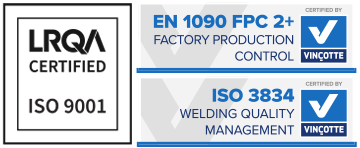Home › Machinery › Treatment and finishing › Pickling and passivating › Pickling and passivation: A technical explanation
Pickling and passivation: A technical explanation
What are pickling and passivation? A technical explanation.
Pickling is a chemical process that removes a microscopically thin layer of material.
This process is applied because damage can occur during the production process (corrosion). The main causes of this damage are:
- Welding can result in a thick weld oxide film, where the chromium content has been reduced. These areas are less resistant to local corrosion.
- Due to blasting, grinding, etc. but also during transport, the material can be contaminated with foreign ferrous metals.
Pickling removes chromium-poor areas and foreign ferrous metals and restores the corrosion resistance.
Depending on the size of the material, this can be done by:
- Applying pickling paste locally with a brush, e.g. for welding seams.
- Dipping in a bath of pickling liquor.
- Treatment with pickling spray, for large surfaces.
The material must be rinsed thoroughly with water after treatment. The pickling sludge containing rinse waters must be carefully collected and removed by a certified waste processor.
After the pickling process, the surface becomes “active” once again and the self-repairing chromium oxide film must be restored. This so-called “passivation process” happens spontaneously when the metal is exposed to air, but requires 24 to 48 hours. It is possible to use chemicals to speed up passivation. If properly executed, natural passivation is qualitatively equivalent to chemical passivation. However, this must take place under optimal conditions, since even the smallest contamination by ferrous metals (e.g. by airborne iron particles) can disrupt the process.
